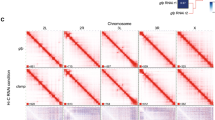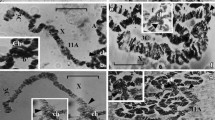Abstract
The mechanism of specific recruitment of the dosage compensation complex (DCC) to the X chromosome of male Drosophila remains an unresolved problem. Recently, a DNA-binding protein CLAMP, which binds to the primary chromosome entry sites (CESs) of the DCC, has been described as a factor involved in X chromosome recruiting of DCC. It has been shown that CESs can recruit DCC to autosomes. In this work, we studied the ability of a well-described CES to support distant interactions in model transgenic Drosophila lines. Negative results were obtained showing that the CES that is bound by CLAMP protein does not support distance interactions.

Similar content being viewed by others
REFERENCES
Kuroda, M.I., Hilfiker, A., and Lucchesi, J.C., Dosage compensation in Drosophila—a model for the coordinate regulation of transcription, Genetics, 2016, vol. 204, no. 2, pp. 435–450. https://doi.org/10.1534/genetics.115.185108
Straub, T., Grimaud, C., Gilfillan, G.D., et al., The chromosomal high-affinity binding sites for the Drosophila dosage compensation complex, PLoS Genet., 2008, vol. 4, no. 12. e1000302. https://doi.org/10.1371/journal.pgen.1000302
Alekseyenko, A.A., Peng, S., Larschan, E., et al., A sequence motif within chromatin entry sites directs MSL establishment on the Drosophila X chromosome, Cell, 2008, vol. 134, no. 4, pp. 599–609. https://doi.org/10.1016/j.cell.2008.06.033
Larschan, E., Soruco, M.M., Lee, O.K., et al., Identification of chromatin-associated regulators of MSL complex targeting in Drosophila dosage compensation, PLoS Genet., 2012, vol. 8, no. 7. e1002830. https://doi.org/10.1371/journal.pgen.1002830
Marcela, M., Soruco, M.M. Chery, J., et al., The CLAMP protein links the MSL complex to the X chromosome during Drosophila dosage compensation, Genes Dev., 2013, vol. 27, no. 14, pp. 1551–1556. https://doi.org/10.1101/gad.214585.113
Alekseyenko, A.A., Ho, J.W., Peng, S., et al., Sequence-specific targeting of dosage compensation in Drosophila favors an active chromatin context, PLoS Genet., 2012, vol. 8, no. 4. e1002646. https://doi.org/10.1371/journal.pgen.1002646
Kyrchanova, O., Chetverina, D., Maksimenko, O., et al., Orientation-dependent interaction between Drosophila insulators is a property of this class of regulatory elements, Nucleic Acids Res., 2008, vol. 36, no. 22, pp. 7019–7028. https://doi.org/10.1093/nar/gkn781
Bischof, J., Maeda, R.K., Hediger, M., et al., An optimized transgenesis system for Drosophila using germ-line-specific C31 integrases, Proc. Natl. Acad. Sci. U.S.A., 2007, vol. 104, no. 9, pp. 3312–3317. https://doi.org/10.1073/pnas.0611511104
Zolotarev, N., Fedotova, A., Kyrchanova, O., et al., Architectural proteins Pita, Zw5, and ZIPIC contain homodimerization domain and support specific long-range interactions in Drosophila, Nucleic Acids Res., 2016, vol. 44, no. 15, pp. 7228–7241. https://doi.org/10.1093/nar/gkw371
Ramírez, F., Lingg, T., Toscano, S., et al., High-affinity sites form an interaction network to facilitate spreading of the MSL complex across the X chromosome in Drosophila, Mol. Cell, 2015, vol. 60, no. 1, pp. 146–162. https://doi.org/10.1016/j.molcel.2015.08.024
Funding
This study was supported by the Russian Science Foundation (no. 17-74-20155).
Author information
Authors and Affiliations
Corresponding author
Ethics declarations
The authors declare that they have no conflict of interest. This article does not contain any studies involving animals or human participants performed by any of the authors.
Additional information
Translated by M. Novikova
Rights and permissions
About this article
Cite this article
Tikhonova, E.A., Mogila, V.A., Georgiev, P.G. et al. The Role of CLAMP Binding Sites in Maintaining of Distant Interactions in Drosophila Transgenic Lines. Russ J Genet 57, 1229–1232 (2021). https://doi.org/10.1134/S1022795421100124
Received:
Revised:
Accepted:
Published:
Issue Date:
DOI: https://doi.org/10.1134/S1022795421100124




